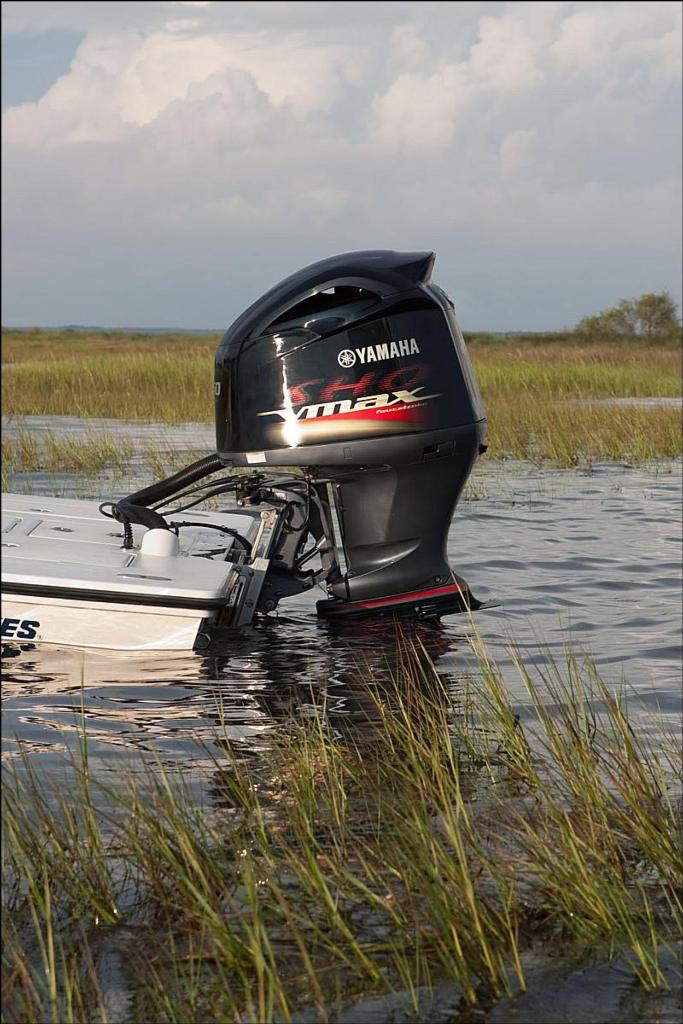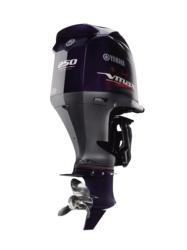Running the Yamaha SHO V Max 250 LA
FLW Outdoors Magazine editors impressed by new line of Yamaha four-stroke outboards

Waking up Tuesday to rain at 6 a.m. didn’t dampen the excitement of testing the new Yamaha outboards. The air was cool but not cold, and the rain was spitting and misting on the 45-minute drive to the test facility in Bridgeport, Ala. A quick safety meeting got everyone on the same page, and then a rundown of the SHO outboard came next.
SHO stands for Super High Output four-stroke technology. The old 3.3L engine has been upgraded to a 4.2L engine. The outboard is 34 pounds lighter than the V MAX Series II two-stroke engine it replaces in the Yamaha product line. No other outboard with the same horsepower is lighter, in fact. At 505 pounds, the 250 purrs like a kitten at idle. Actually it sounds like the low rumble of a high-performance sports car. But when it was time to hit the gas, the engine was surprisingly quiet, even without any muffler, a first for the Yamaha four-strokes.
Many folks don’t realize that a four-stroke means no oil reserve under the back deck. Owners can very easily change their own oil through a filter that is easy to access. It is even tilted upward with a scoop under it to remove any of the drip problems (i.e. smoke from spilled oil) from the whole process.
I asked pro angler Dave Wolak how much oil he went through last season on tour with his 3.3L F225 four-stroke, and he changed his oil only twice. We’re talking maybe 12 quarts in a year of hardcore competitive fishing. That’s impressive, and this engine is even better. That’s hundreds of dollars saved in oil if you fish and run your boat a lot – thousands over the life of the outboard.
You might hear the engine referred to as the VF250LA. The V is for VMAX, and F is for four-stroke. The LA stands for L shaft length, which is the 20-inch model, and A for the first generation of this outboard. But the thing to keep in mind here is we’re talking about a four-stroke engine that has springs and cylinders and more parts than a two-stroke. All these things add weight, yet these outboards are as light as, or lighter than, two-strokes.
OK, the proof is in the pudding – namely, how does it handle on the water in real life? Well, two of us jumped in the boat. We idled past the no-wake zone, and Wolak leaned over to ask, “Are you ready?” “Let it rip,” I said. In an instant we were on pad and rapidly approaching 60 mph. Then 65. Then 70, 71, 72, 73 and 74 mph. Wow. The Z520 is running 74 mph, going upriver against a heavy current. Unreal.
He came off pad for a second and then jumped back up on plane in an instant. Then back down to a low speed, and we jump back into full speed. This was just a sick display of not only the incredible hole shot but also the midrange power the outboard has.
One nice thing I noticed is there wasn’t that “clunk” when you went into and out of gear. I was also very impressed with the responsiveness of the motor. No hesitation and immediate power. It was  smooth, quiet and powerful, and it was a four-stroke.
smooth, quiet and powerful, and it was a four-stroke.
While coming back down the river, Wolak demonstrated a situation that any angler who has fished a shallow fishery has encountered at least once. You’re fishing a really shallow area, or you have a problem while running, and have to shut down in shallow water. You can either idle for a long time to get to deep enough water again to get on pad, or you can drive in a circle until you build up enough speed to get on plane.
In half a turn, the boat was buoyed up to the surface, and we were on plane. Unreal!
Anglers and boaters have a choice of 200-, 225- and 250-hp models in the V MAX SHO line. All the technologies are the same, just some different size and horsepower options.
The secret is in increased airflow, lighter weight and borrowed technology of plasma-fused metals in the bored-out cylinders. The result is increased displacement, which means more power. But the other advantage is these metal powders are passed in front of a plasma arc and bonded to the cylinders to create an ultrathin layer on the actual cylinder that is 60 percent harder than steel.
A side effect is that microscopic pockets form in the metals. These pockets hold oil. The result is no more cylinder scrapes and greatly reduced friction, a natural thief of power. Also because the friction is down, the heat is down and the overall cooling in the engine is increased.
The thing is most folks won’t even see all the little things they fixed, lightened, redesigned and designed from scratch to achieve this three-year-in-the-making motor. The overlying message I found while studying the engine is that there are so many things that make this engine a great investment and add to its performance that you can’t say it’s just one thing that makes it better.
Small things like retooled water intake to make sure the engine gets enough water pressure in all types of situations to the redesigned air intake and transfer system to make sure the air is not only cooler but more abundant. Engines run better on cooler mornings because the fuel and air are denser then. This is one thing that Yamaha can simulate to make the outboards perform better.
I think these engines will set a new bar. For those that don’t know, two-strokes are going away. Manufacturers will stop producing two-strokes very soon because of EPA regulations. In fact, Yamaha said only the 150 and 175 two-strokes will remain after Jan. 1, 2010. The dealers who already have the other two-strokes can continue to sell them, but no more are going to be manufactured.
I am seriously impressed with this four-stroke outboard. I thoroughly enjoyed being able to test the motor on both a Ranger Z520 and the new Skeeter FX 21. The weather certainly won’t rain on this parade. Check the www.yamahagamechanger.com Web site later this week for a lot of technical information on all the new offerings from Yamaha for 2010. We’ll have more updates on the other products soon as well.
Hop over to our YouTube channel to see some videos from the outboard test Tuesday morning. You can also read our story previewing the test run.